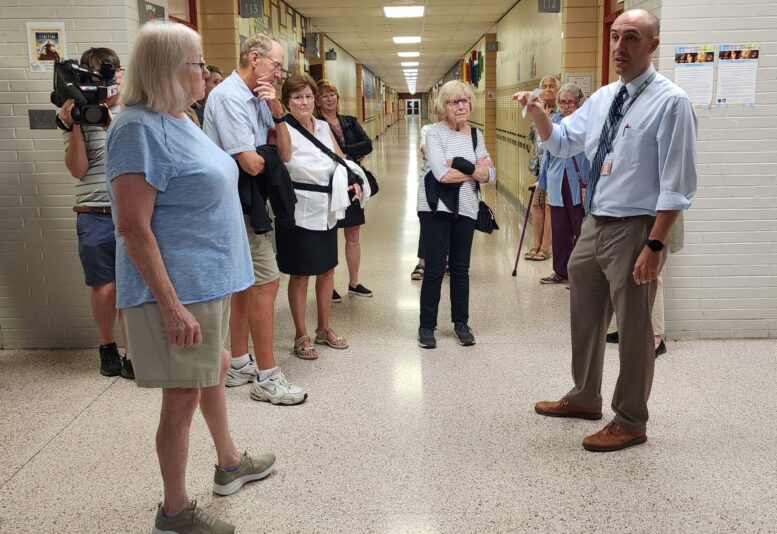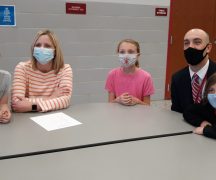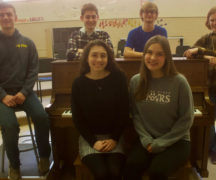By JAN LARSON McLAUGHLIN
BG Independent News
Nearly 40 people tagged along on a tour of the 60-year-old Bowling Green High School with Principal Dan Black on Wednesday evening.
They fell into three basic camps. Those certain that students and teachers deserve a new building. Those convinced that all existing building problems could be fixed. And those on the fence.
Those on the tour saw the same school, but came to different conclusions. One camp saw evidence of poor learning environments, while the others saw proof that the building still had good bones.
“I’m having some flashbacks,” said Brenda Fite, who went to school at BGHS and returned to the city recently after being away for 25 years. She admitted looking at Perrysburg schools for her son who is in the eighth grade.
But Fite and her spouse chose Bowling Green with hopes that improvements would be coming.
“Hopefully he’ll have a senior year in a new high school,” Fite said, referring to the $72.8 million bond issue on the November ballot for a new high school. “It’s important to me – not just for my kids, but for everybody. Kids’ shouldn’t have to worry about a ceiling leaking on them.”
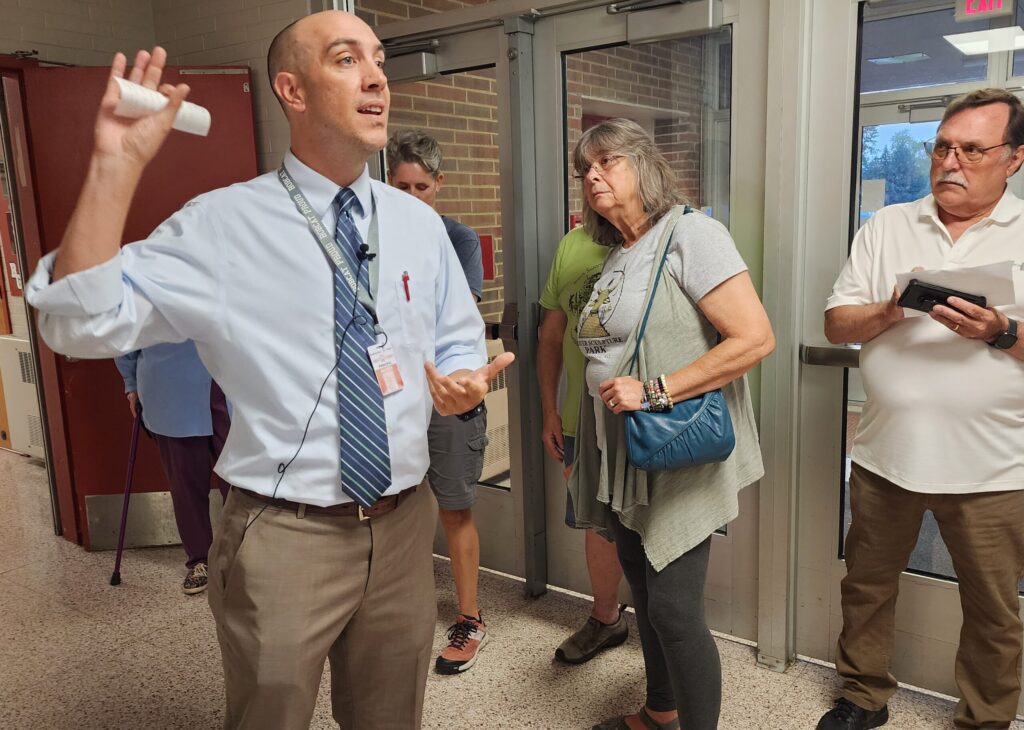
Mike Hagen, jotted down notes as he took the tour.
“I’m on the fence – that’s why I’m here,” said Hagen, who started the Pinnacle Plastics Products plant in Bowling Green. “I’m all for learning. But I wanted to see the building.”
Mid-tour, Hagen was still on the fence. But Richard Schultz was planted firmly on the side of keeping the current high school.
“I’ve never seen it inside, other than for pancake breakfasts,” Schultz said. “There’s nothing wrong that can’t be fixed.”
If the high school needs more room, then an addition could be added. Schultz said he would prefer to see the district tackle the aging elementaries one at a time. But the new high school is not needed, he said.
“They want a Taj Mahal,” Schultz said of community members pushing for the new high school plan.
Tammi Sharp joined the tour so that she could intelligently talk about the need for the school bond issue to other voters.
“I always support the school levies. And I’ll support this one,” Sharp said.
Jim Hubbell started the tour as a definite maybe.
“I’m a maybe on the new high school,” he said, noting that he voted against the last school levy. However, the more he saw on the tour, the more he was convinced of the need.
“I’m more leaning toward a ‘yes’ vote after seeing everything,” Hubbell said.
Frances Brent was a supporter long before she stepped off for the tour.
“We need to get into the 21st century,” she said. “Our kids should not be asked to overcome their environment to learn.”
As for preserving the 60-year-old building, school board member Norm Geer said he’s sure the building could be renovated – but at what cost to the district and students?
Geer referred to his 1964 Nova station wagon that he could have kept and maintained. “But my car would still be a ‘64,” he said.

According to the Ohio Facilities Construction Commission, it would cost $47.5 million to renovate the high school, compared to $64.1 million to build new. That is close to the district cost of $62.3 million for the new high school, minus the cost for the activity center. Using the OFCC’s threshold for a feasible renovation, the state would not co-fund a renovated BG high school because the costs are too high.
Black pointed out several “challenges” to those joining the building tour. The classrooms, which were built for a different era, are too small. There is no room for group learning in most classrooms, nor collaborative learning between classes.
Unlike most schools nowadays, BGHS still has chalkboards. “That’s not because they’re a great educational tool,” Black said.
“Today’s learning model is so different than this building was designed for,” Black said.
Every student has a chromebook, many that need charged during the day. But the classrooms were constructed with very few outlets, so teachers often plug in extension cords with powerstrips for students to use.
Steam from the boiler system has destroyed wooden doors, and melted glue holding down hallway tiles. In one classroom, the steam caused the ceiling tiles to cave in. The boilers create such uneven heat that students in one section of the school need coats and gloves, while students in another area are in shorts and sandals, Black said.
During frigid winter weather over the holiday break last year, the pipes burst in the art rooms, causing water to cascade into the school offices below.
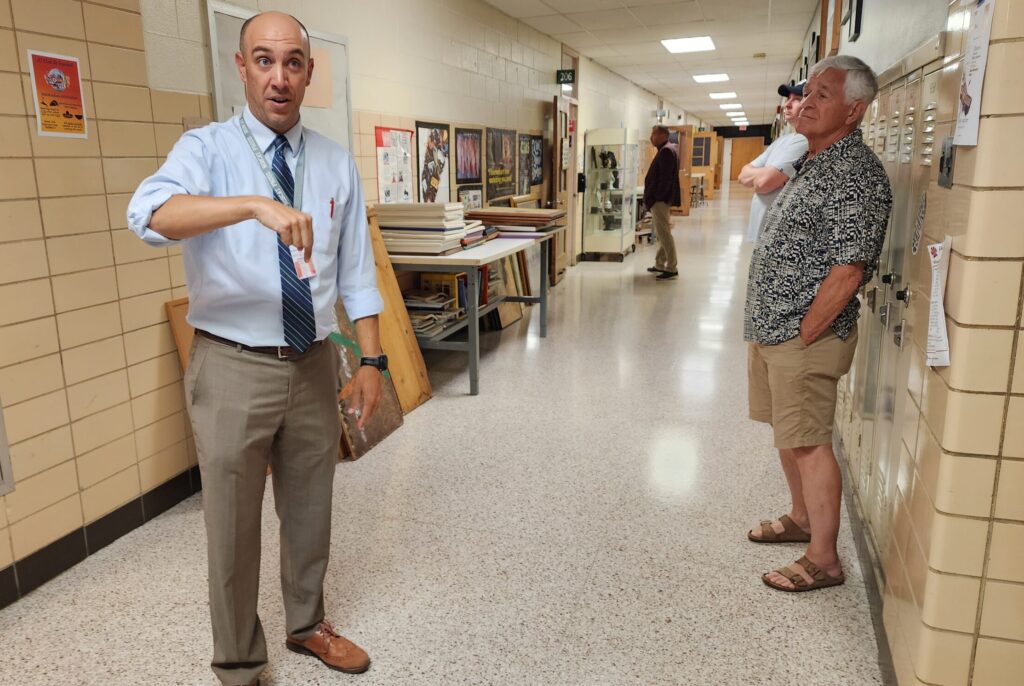
The science rooms barely qualify as science classrooms, since most don’t even have access to water in them, Black said.
The water pressure at the school is so low that when students flood to the restrooms in between classes, sometimes the toilets don’t fully flush. To show the poor water pressure, Black and Assistant Principal Beth Utz performed a “science experiment” in the hallway, with Black showing how the water fountain stream changed each time Utz flushed a nearby toilet.
The main cafeteria and annex don’t have enough room for the nearly 800 students to eat over three shifts.
Black also said there is only one restroom that can accommodate a student who uses a wheelchair. And the speech therapist meets with students in a former closet, which requires speech students to walk past rows of other students to get to the closet.

